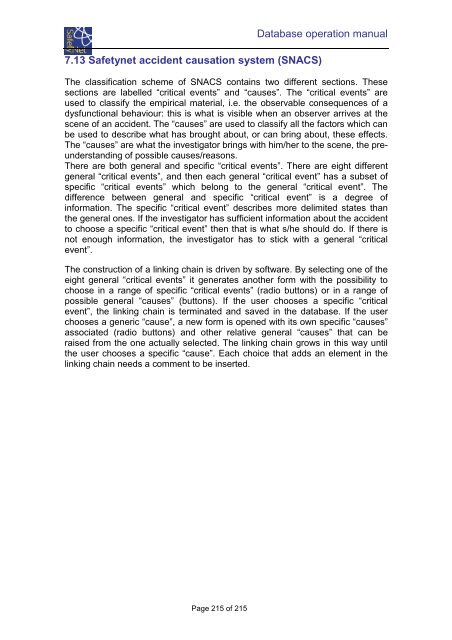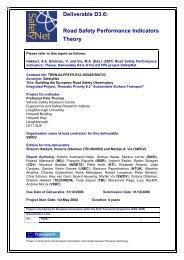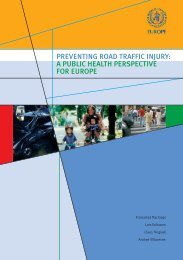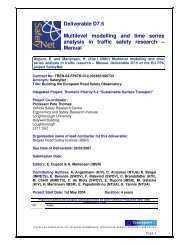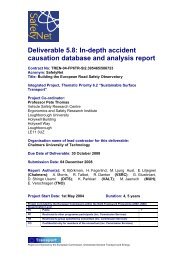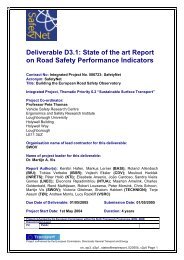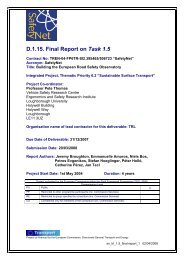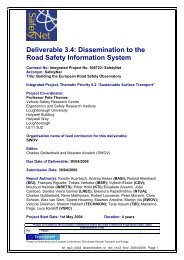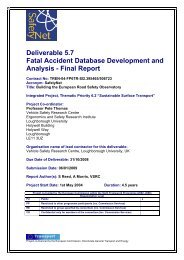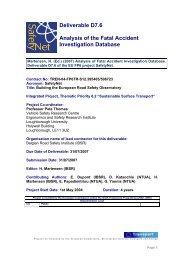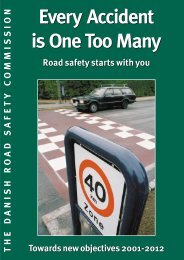Glossary of Data Variables for Fatal and accident causation ... - ERSO
Glossary of Data Variables for Fatal and accident causation ... - ERSO
Glossary of Data Variables for Fatal and accident causation ... - ERSO
You also want an ePaper? Increase the reach of your titles
YUMPU automatically turns print PDFs into web optimized ePapers that Google loves.
7.13 Safetynet <strong>accident</strong> <strong>causation</strong> system (SNACS)<br />
<strong>Data</strong>base operation manual<br />
The classification scheme <strong>of</strong> SNACS contains two different sections. These<br />
sections are labelled “critical events” <strong>and</strong> “causes”. The “critical events” are<br />
used to classify the empirical material, i.e. the observable consequences <strong>of</strong> a<br />
dysfunctional behaviour: this is what is visible when an observer arrives at the<br />
scene <strong>of</strong> an <strong>accident</strong>. The “causes” are used to classify all the factors which can<br />
be used to describe what has brought about, or can bring about, these effects.<br />
The “causes” are what the investigator brings with him/her to the scene, the preunderst<strong>and</strong>ing<br />
<strong>of</strong> possible causes/reasons.<br />
There are both general <strong>and</strong> specific “critical events”. There are eight different<br />
general “critical events”, <strong>and</strong> then each general “critical event” has a subset <strong>of</strong><br />
specific “critical events” which belong to the general “critical event”. The<br />
difference between general <strong>and</strong> specific “critical event” is a degree <strong>of</strong><br />
in<strong>for</strong>mation. The specific “critical event” describes more delimited states than<br />
the general ones. If the investigator has sufficient in<strong>for</strong>mation about the <strong>accident</strong><br />
to choose a specific “critical event” then that is what s/he should do. If there is<br />
not enough in<strong>for</strong>mation, the investigator has to stick with a general “critical<br />
event”.<br />
The construction <strong>of</strong> a linking chain is driven by s<strong>of</strong>tware. By selecting one <strong>of</strong> the<br />
eight general “critical events” it generates another <strong>for</strong>m with the possibility to<br />
choose in a range <strong>of</strong> specific “critical events” (radio buttons) or in a range <strong>of</strong><br />
possible general “causes” (buttons). If the user chooses a specific “critical<br />
event”, the linking chain is terminated <strong>and</strong> saved in the database. If the user<br />
chooses a generic “cause”, a new <strong>for</strong>m is opened with its own specific “causes”<br />
associated (radio buttons) <strong>and</strong> other relative general “causes” that can be<br />
raised from the one actually selected. The linking chain grows in this way until<br />
the user chooses a specific “cause”. Each choice that adds an element in the<br />
linking chain needs a comment to be inserted.<br />
Page 215 <strong>of</strong> 215


